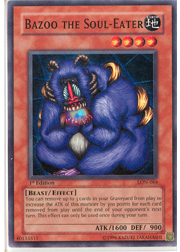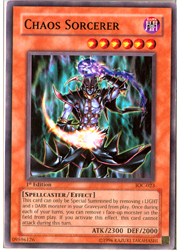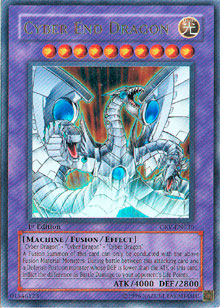Did you enjoy last week’s article about card presence? I hope that you did, because this week’s article will be building a bit on concepts that we discussed last time. I promise that there’s less math this time, though. Today, I’m going to talk to you about “tempo” and how it relates to the Yu-Gi-Oh! TCG. Sounds fun, huh?
Tempo is another one of those concepts that you probably know more about than you realize, unless you spend a lot of time in complicated and technical card-playing discussions with other players. Put simply, the tempo is the pace of the game—the speed at which the game is won. And winning is what we want to do, right? Right! Let’s learn more!
If you want to be the player who wins (and I’m going to go out on a limb here and assume that you do), then you want to be the player who’s controlling the tempo. This means you want to be in control of how resources are lost, including cards and life points. That certainly makes sense, so how do you get and hang on to control of the game’s tempo? There are two factors you’ll need to be able to manage, one of which we talked about last week. These are card presence and exchange, as well as life point exchange. For purposes of this article, we’ll be focusing most closely on the card exchange part of the equation.
In terms of card presence, the more cards that are exchanged, the faster the tempo of the game. All those one-for-one exchanges we talked about last week cycle the cards rapidly, keeping the benefit of the game on the side of the player who topdecks the best cards. On the other side, the draw . . . pass, draw . . . pass kind of play that offers no exchanges fills the players’ hands with cards and options, while at the same time it vexes spectators by dragging out the game. Do you see how card exchange helps shape the tempo of the game?
From there, it’s easy to recognize that different types of decks will rely on totally different tempos to function at their best. Gone are the days when everyone’s great idea was to rip 8000 life points away from the opponent in as few turns as possible! Nowadays, there are a lot more ways to play the game, and they all work at their own specific speed.
In general, decks that rely on combos or run off of a lockdown engine will strive for a slow tempo. Players with these kinds of decks want to stall the game while they gather all the cards they need in order to pull off the combo or to get the lock in place, then push along to get their win condition. A slow exchange of cards and slow loss of life points works in favor of these kinds of decks.
Conversely, a player running a Beatdown deck or a deck designed to topdeck well wants a fast tempo. These players know they’ll maintain the advantage when cards are exchanged quickly, because once the game comes down to empty hands and topdecking, he or she stands a better chance of winning. Remember the one-for-one discussion in last week’s article? Grabbing at rapid card-for-card exchanges helps out these kinds of decks. The speedy player wields a great deal of control over how many cards each player has by expending his or her own and forcing the opponent to try and keep up by playing his or hers in response. The loss of cards will also limit the opponent’s options for attacking, which helps control how quickly life points are lost.
That’s all a bit general, so let’s get practical for a moment and look at some specific examples of decks that you’ve probably seen lately. You’ll get a better understanding of what I mean if, as you read these over, you think about your past matchups with these decks. Try and remember the tempo of the game as well as you can. Did it seem to follow these assessments, and did the deck work? Try and spot the correlations.
Bazoo Return
 This deck demands just about the fastest tempo in the format. When it works, games are over very quickly. Rapid card exchanges push it into topdecking, and once it gets there, both of its combo components (Bazoo the Soul-Eater and Return from the Different Dimension) become great draws. Return is hardly ever a dead card, since even without Bazoo, you’ve got multiple copies of D. D. Assailant and D. D. Warrior Lady (sometimes even D. D. Warrior) removing themselves from play. Without a Return, Bazoo can still become a 2500 ATK beatstick for one turn as well as a solid wall during your opponent’s.
This deck demands just about the fastest tempo in the format. When it works, games are over very quickly. Rapid card exchanges push it into topdecking, and once it gets there, both of its combo components (Bazoo the Soul-Eater and Return from the Different Dimension) become great draws. Return is hardly ever a dead card, since even without Bazoo, you’ve got multiple copies of D. D. Assailant and D. D. Warrior Lady (sometimes even D. D. Warrior) removing themselves from play. Without a Return, Bazoo can still become a 2500 ATK beatstick for one turn as well as a solid wall during your opponent’s.
This deck can handle a faster tempo than other Return from the Different Dimension variants, because it only needs to remove a handful of monsters from play and any monsters will do. Cards like Strike Ninja and Divine Sword – Phoenix Blade have restrictions on the kinds of monsters they can remove from your graveyard, so it often takes longer to “load” your out of play area.
Strike Ninja Return
This deck is fast, too. It’s not quite as fast as Bazoo Return, since the player needs a longer game in order to take full advantage of Strike Ninja’s ability to dodge Sakuretsu Armor– and Smashing Ground–type cards.
In addition, Strike Ninja’s affinity for Dekoichi the Battlechanted Locomotive (a Dark type which fuels the Ninja’s effect quite nicely) will naturally create a slightly slower tempo than Bazoo Return. Dekoichi fills the graveyard to provide fodder for Strike Ninja’s effect, but at the same time it slows the game by adding to the player’s card resources and not often attacking. It works out well, creating a faster tempo than is ideal for a Warrior Toolbox, but still denies Bazoo Return the degree of speed that it favors.
Warrior Toolbox
You all know that this deck is played relatively fast, and that it usually does quite well in topdecking situations, owing to multiple copies of Cyber Dragon (great draw) and multiple D. D. Assailants. And don’t forget that all those copies of Reinforcement of the Army bring useful precision in topdecking situations, allowing the player to seek out what will work best. This helps the deck fare better in the late game than the average Beatdown or Chaos, where the topdeck is thrown more into the realm of random chance.
Chaos
 Chaos moves a bit more slowly, favoring a moderate tempo. While these kinds of decks can topdeck well with Cyber Dragon and Chaos Sorcerer, players are usually out to gain a bit of card advantage by relying on a relatively controlled speed scenario. You’ve got to get those Light and Dark monsters in the graveyard, after all. Dekoichi the Battlechanted Locomotive is a popular pick for Chaos, and it does slow down card exchange. Also, since Don Zaloog and Ninja Grandmaster Sasuke can be weak if they come up at the wrong moment in topdecking situations, a moderate tempo that keeps more options open works best.
Chaos moves a bit more slowly, favoring a moderate tempo. While these kinds of decks can topdeck well with Cyber Dragon and Chaos Sorcerer, players are usually out to gain a bit of card advantage by relying on a relatively controlled speed scenario. You’ve got to get those Light and Dark monsters in the graveyard, after all. Dekoichi the Battlechanted Locomotive is a popular pick for Chaos, and it does slow down card exchange. Also, since Don Zaloog and Ninja Grandmaster Sasuke can be weak if they come up at the wrong moment in topdecking situations, a moderate tempo that keeps more options open works best.
Soul Control
This deck relies a bit more on combos, since it wants to have cards like Brain Control and Soul Exchange ready in-hand, along with the Monarch of choice, in order to go off and start claiming advantage. That said, Soul Control decks are still combat- and resource advantage-oriented decks, and not exactly Combo decks. That means this deck is still going to make card exchanges in order to open up the field to attack. It clicks along at a moderate speed, and won’t want to run quite as slowly as a Lockdown or pure Combo deck will.
Dekoichi the Battlechanted Locomotive and Magical Merchant naturally slow down the tempo a great deal, and they also enable the deck to effectively use Pot of Avarice.
Cyber-Stein One-Turn Kill
Pure combo, this is the slowest tempo deck in the current environment, perhaps rivaled only by Lockdown Burn . . . unless the player has an amazing degree of luck with opening draws! Then it’s all over rather quickly.
 Stall, stall, stall—that’s what this deck does. With the piercing damage capabilities of the mighty Cyber End Dragon and Big Bang Shot, this deck doesn’t care how many monsters the opponent gets to set. Cyber-Stein One-Turn Kill decks might strive for card advantage as a matter of game principle, but they have no real core reason to do so. All the player wants is a Cyber-Stein and a Giant Trunade, and that’s about it! Apart from getting those cards, the other objective is not to die, so the deck might run one-for-one cards like Sakuretsu Armor and Widespread Ruin, but more for defensive purposes than for tempo control.
Stall, stall, stall—that’s what this deck does. With the piercing damage capabilities of the mighty Cyber End Dragon and Big Bang Shot, this deck doesn’t care how many monsters the opponent gets to set. Cyber-Stein One-Turn Kill decks might strive for card advantage as a matter of game principle, but they have no real core reason to do so. All the player wants is a Cyber-Stein and a Giant Trunade, and that’s about it! Apart from getting those cards, the other objective is not to die, so the deck might run one-for-one cards like Sakuretsu Armor and Widespread Ruin, but more for defensive purposes than for tempo control.
Dekoichi and Magical Merchant also slow down this deck’s tempo by doing what they do best, and that’s digging for the key cards that the player needs to get into play.
It’s easier to grasp the idea of how tempo influences the game after looking at the individual deck types, right? But how is understanding the effect that tempo control has on a deck’s performance actually going to help you?
First, it will help you build your decks so they work the way you want them to. Second, it will help you make the right tactical decisions when you’re facing someone else’s deck, including the right side deck choices. Third, it will help you come up with innovative tech when something new and tough to beat arises in your metagame. In other words, it pushes you out of that “instinctive” mode of playing and deckbuilding, and enables you to really think about and understand what you’re trying to do.
When you build your deck, you’ll know that you need to include cards that help shape the tempo in your best interests. You’ll actually know the reasoning behind certain cards, why they are there, and why they work better than similar cards. Your card choices will move beyond, “Well, everyone puts in Sakuretsu Armor so I’ll throw one in and see how I like it . . . hmm . . . lots of people play this and that . . . I guess they must be good, let’s put in a couple of those . . . oh, I kind of like this card too, let’s put that in!” approach to deckbuilding, and you’ll gain a better understanding of why some cards work in your deck and others don’t. Your decks will run better when the cards you put in are designed to work together to get your tempo going and keep it going, and when you understand which cards they are and what exactly they do.
When you’re trying to win a match, you’ll be able to analyze your opponent’s deck type and tempo, and you’ll know what will throw it off. You’ll know that you should lean hard on a Combo deck with a slow tempo, so you can thwart that combo before it can hurt you. If you’re facing a speedy Beatdown deck, you might want to slow down the tempo so you can depend more on card advantage to avoid being forced into a topdecking situation.
When it’s time to side deck, you’ll know that you need to switch in cards that will turn the speed of the game in your favor, rather than just throwing in a few cards intended to work against specific cards in the opponent’s deck. Instead of thinking “I’ll just put in an extra Giant Trunade to get rid of those copies of Messenger of Peace,” and expecting that to solve all your problems, you’ll understand that adding in cards that will help you keep the tempo at a pace which will seriously hurt your opponent’s deck are what will help you win. Single copies of tech cards certainly have their place, but be careful that you don’t fall into the habit of never thinking beyond, “Oh, this one card will work well against that one card and that’ll be enough,” when you side deck. You want to make sure you’re the one who’s controlling the pace of the game, and that will often require more than one or two cards.
We’ve certainly covered a lot of ground today, and I hope that the next time you’re at a tournament, you’ll think over what you’ve read as you play. Have you applied last week’s card exchange discussion to your duels yet? Make sure that you work at understanding the card exchanges until you’re confident you’ve got it, and then start paying attention to tempo. Look at what the different cards and exchanges do to speed up or slow down the game, and compare one deck with another. Evaluate your losses carefully, paying attention to the rate at which the game moved along. You may find that a better understanding of the speed at which the game moves along is what you’ve been needing in order to build more effective decks, make smarter side deck choices, and improve your chances at winning. See you in the Top 8!